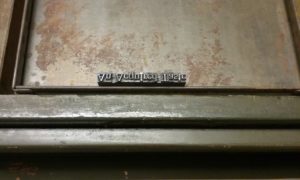The World Before QWERTY
Can you type without looking at the keyboard? This used to be a skill taught to people who wanted secretarial or clerical jobs. Now of course many of us type quickly because we use computers on a daily basis. But what about the predecessor to the keyboard we know? This is it – a typecase, filled with individual letters which had to be assembled by hand to create anything which needed to be printed.

Each cell contains the same letter, symbol, or space. Do you think you could use this without looking? Remember that the letter on the piece of type would be in mirror image, so looking at it may be confusing anyway. A good typesetter or composer would have been able to set type without looking at the pieces of type, remembering the way around the case in the same way we remember our way around the keyboard – through practice. That way he or she could keep looking at the text which needed to be copied and could work faster, with one hand holding the composing stick with the assembled words and the other picking up more letters.

But there’s another thing – actual physical type doesn’t have an autocorrect, so letters sometimes went in upside down, backwards, or were the wrong letters in the first place. What is more, the compositor could make a mistake in picking up type, but the mistake could also have been made by the person who put the type away. If an “a” was accidentally put into the “o” cell (which is immediately above it), the person setting type the next time around might not notice it and might use the wrong letter. Or the “wrang letter” as the end of that last sentence might have looked if I had been setting it by hand and had had this problem.
Nowadays of course this is only a problem for a very few people, and a ‘printer’ has changed from being a person who used a press to the machine which has replaced both that person and the press. As our world becomes more automated, what other skills will become less necessary? With improvements in voice-recognition software, will today’s William and Mary students find themselves explaining to their children about how they used to have to type all of their work?

Some of Swem Library’s printing equipment, long stored in the basement, is on display on the second floor of the library in the rotunda above the entrance to Special Collections. This includes a typecase like the one pictured here, known as a California Jobbing Case.

